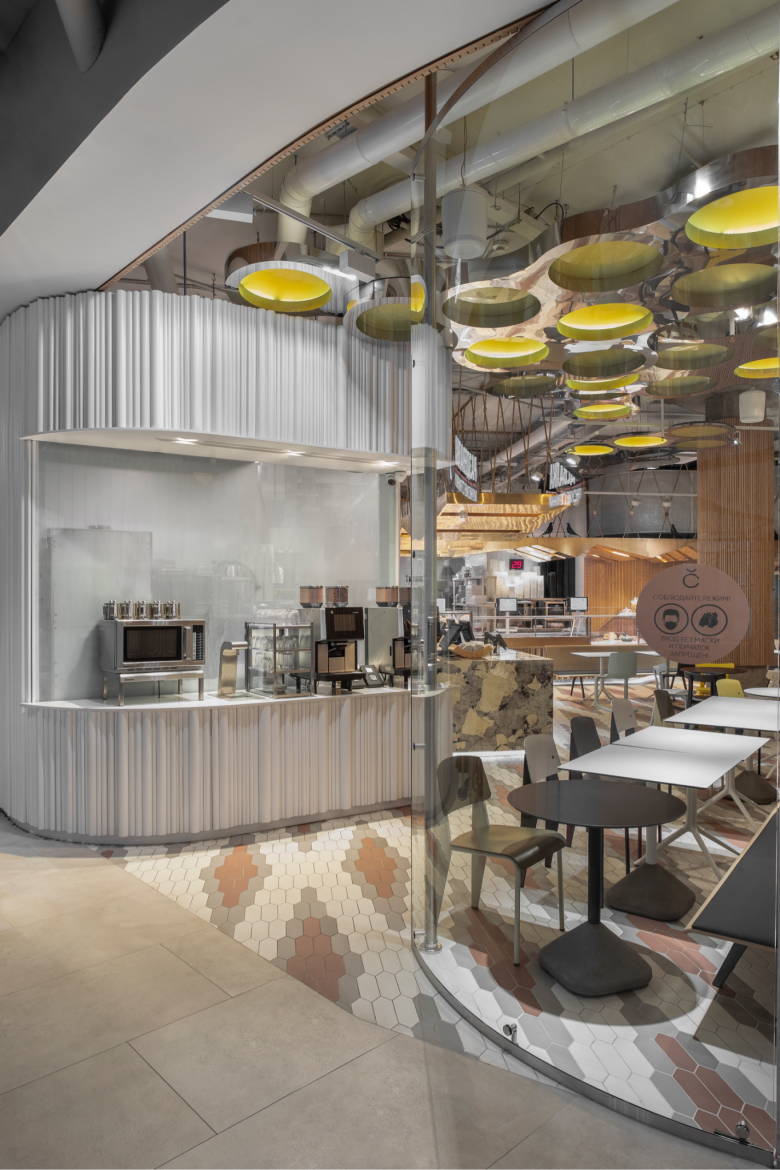

Founded in late 2000 by hospitality entrepreneur Evgeniy Katsenelson, the Bratya Karavaevi restaurant chain has since gone leaps and bounds, spanning an impressive network of no less than 42 across Moscow‘s sprawling metropolitan area. Following a number of successful establishments for the happy few, the family restaurant concept was an endeavour in quite a different directions, but its simple honest offerings, ranging from salads and soups, to bread, pastries and also Jewish delicacies has struck a sensitive chord with gourmets from different demographics, making it Katsenelson’s most successful venture to date. Bratya Karavaevi‘s newest outpost is located in Sokolniki, an upscale neighbourhood in the northeast of the Russian capital, bordering on the expansive greens of Sokolniki Park. A stone’s throw away from the park sits Sokolniki Shopping Centre where the restaurant occupies a 150 sqm. (1,615 sq.ft.) ground floor unit, wedged in between a coffee parlour and a cosmetics store.
The interior design sees a renewed collaboration with architect Evgeniy Shchetinkin, head of the newly established Moscow-based practice Arch Department. Interestingly, inspiration was drawn from the American National Exhibition, a remarkable, but also boldly capitalist showcase in 1959 of American fashion, cars, model homes, cosmetics and household appliances held on the grounds of the aforementioned park, but the design also references the works of a number of iconic designers and artists. Walls and support beams covered in both panels of slatted wood and tiles, and a ceiling overlaid by honeycomb-shaped clouds of reflective metal, all form the backdrop of a sculptural canopy in shimmering brass, inspired by the exhibition’s main pavilion, hovers over the service counter and follows its contours. The volume’s suspensions cheekily reference architect Buckminster Fuller‘s geodesic structures. Decorative oval panels echo Charles Eames‘ multi-screen video installation at the prestigious Sokolniki exhibition, and are paired with George Nelson‘s wall clocks.
Custom-made tiles, created by ETRURIA design, are inspired by the diamond-shaped texture of one of the many carpets at the Eames House in Los Angeles, an existing old brick building with ceramic flooring, as well as the modular honeycomb structure of the exhibition pavilions. In order to adapt to the shopping centre’s existing indoor entrance, comprising basically of a curved glass partition, the façade needed to be tweaked considerably, resulting in a coffee service station being positioned there, comprising tubes of various sizes which, collectively, feature a similarly curved shape. Right behind it, a dish washing unit is situated. Bratya Karavaevi‘s furniture and accessories have been selected in compliance with the project’s connection to the aforementioned American designers, and whose iconic legacy is reissued by Vitra. We’re talking Jean Prouvé‘s Standard SP chairs, the All Plastic Chair and Jasper Morrison‘s EVO-C chairs are used in the interior of the café.
Designed by Arch Department
Images © Arch Department
Photography: Polina Poludkina

















